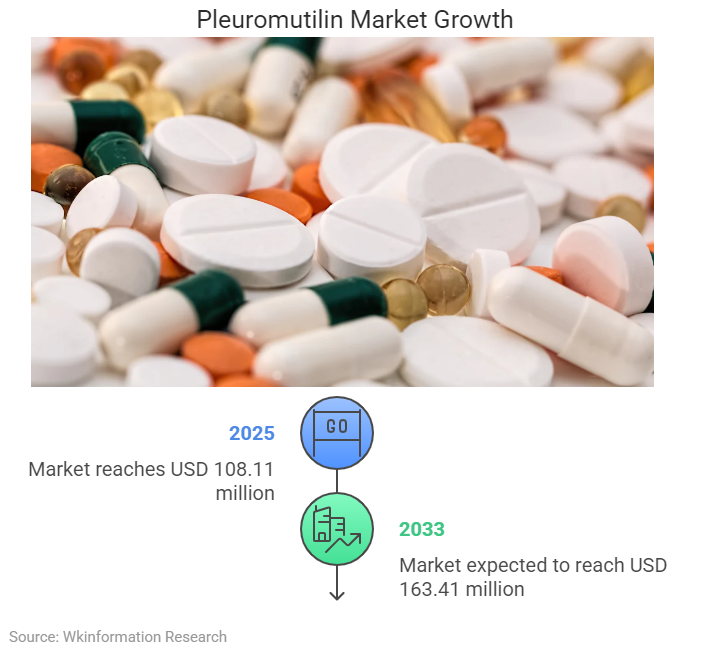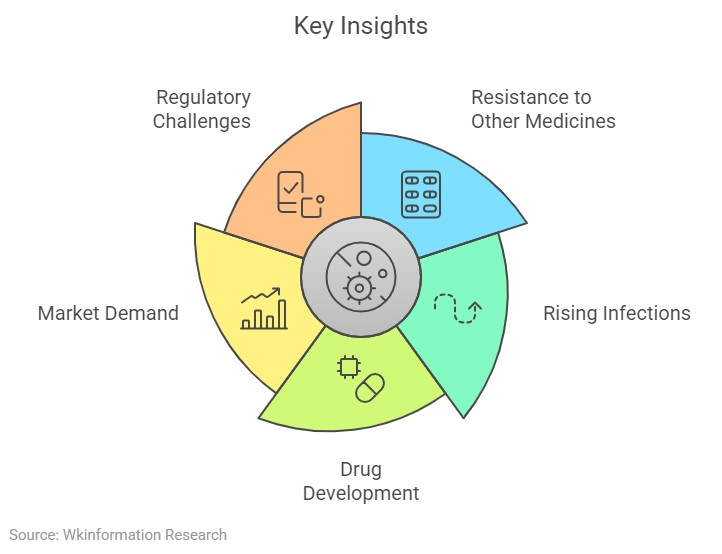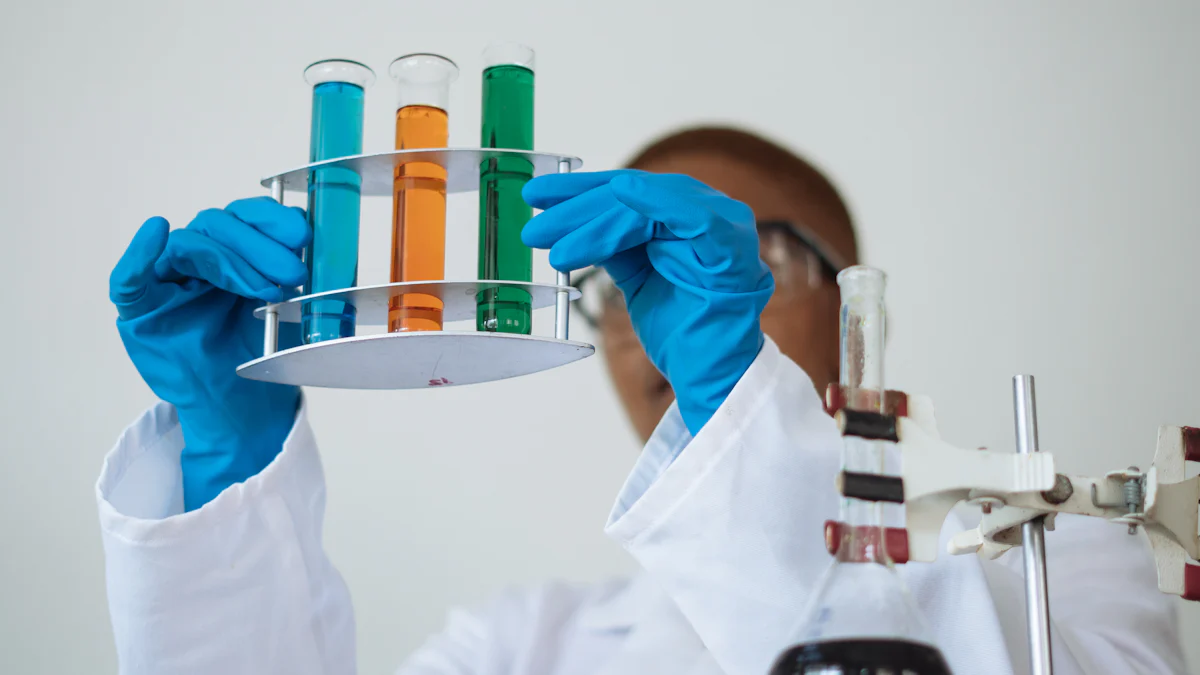
The global pleuromutilin market plays a pivotal role in addressing the growing threat of antibiotic resistance. Pleuromutilin antibiotics, known for their effectiveness against resistant bacterial strains, are gaining recognition as critical tools in both human and veterinary medicine. The market will reach USD 108.11 million in 2025 and is expected to reach USD 163.41 million by 2033, with a CAGR of 5.3% from 2025 to 2033. Rising antibiotic resistance has intensified the demand for innovative solutions, prompting pharmaceutical companies to invest in research and development. These efforts focus on creating next-generation pleuromutilins and exploring their applications in combination therapies. This momentum underscores the market’s potential to meet global healthcare needs while advancing sustainable antibiotic practices.
Key Insights
- Pleuromutilin antibiotics help fight germs that resist other medicines. They are used in both people and animals.
- More people need pleuromutilins because of rising infections and tough germs.
- Drug companies are working to create better pleuromutilin medicines and mixes to work stronger.
- Newer markets need pleuromutilins since they have many resistant germs and few good treatments.
- Rules and high costs make it hard for companies to make new pleuromutilin medicines.

Market Dynamics
Key Drivers
Rising prevalence of bacterial infections
The increasing incidence of bacterial infections worldwide has created a pressing need for effective antibiotics. Pleuromutilin antibiotics, known for their ability to combat resistant pathogens, have gained attention as a critical solution. The global pleuromutilin market benefits from this demand, as healthcare providers seek alternatives to traditional antibiotics that are losing efficacy.
Increasing focus on antibiotic resistance solutions
Antibiotic resistance poses a significant threat to global health systems. Governments and healthcare organizations are prioritizing the development of innovative treatments to address this issue. Pleuromutilins, with their unique mechanism of action, offer a promising avenue for combating resistant bacterial strains. Pharmaceutical companies are investing heavily in research to enhance the efficacy and safety profiles of these drugs, further driving market growth.
Advancements in pleuromutilin drug development
Recent advancements in pleuromutilin drug development have expanded their therapeutic potential. Key innovations include the creation of new analogs with improved antimicrobial activity and reduced side effects, as well as the exploration of combination therapies to enhance effectiveness.
Restraints
High costs associated with research and development
Developing pleuromutilin antibiotics requires significant financial investment. High research and development costs deter smaller companies from entering the market, limiting competition and innovation. This financial burden also slows the introduction of new products, affecting the market’s overall growth.
Regulatory challenges in drug approval processes
Regulatory bodies impose stringent guidelines for the production and approval of pleuromutilin drugs. These requirements increase costs and delay market entry, particularly for smaller pharmaceutical firms. Compliance with safety and efficacy standards remains a critical hurdle, impacting the availability of pleuromutilins in regions with high demand.
Opportunities
Emerging markets with unmet medical needs
Emerging markets present significant opportunities for the pleuromutilin market. These regions face a growing burden of antibiotic resistance and lack access to effective treatments. Expanding the use of pleuromutilins in human healthcare and veterinary medicine can address these unmet needs. Advancements in drug formulation technologies, such as improved stability and delivery methods, further enhance their potential in these markets.
Potential for pleuromutilin use in veterinary medicine
Pleuromutilins have shown great promise in veterinary medicine, particularly for treating respiratory diseases in livestock and poultry. Their effectiveness against common infections in animals makes them a valuable tool for combating antimicrobial resistance in agriculture. The table below compares their applications in veterinary and human medicine:
| Application Area | Use of Pleuromutilins | Key Points |
|---|---|---|
| Veterinary Medicine | Treating respiratory diseases in livestock and poultry | Increasing use due to effectiveness against common infections in animals. |
| Human Medicine | Exploring systemic use against resistant bacterial infections | Focus on addressing antibiotic resistance and potential for new drug development. |
| Historical Context | Tiamulin approved for veterinary use in 1979; Retapamulin for humans in 2007 | Shows the timeline of pleuromutilin development and its applications in both fields. |
The growing awareness of antimicrobial resistance in both human and animal health sectors is expected to boost demand for pleuromutilins across these applications.
Key Trends Shaping the Pleuromutilin Market

Growing investment in antibiotic R&D
The global pleuromutilin market is witnessing increased investment in antibiotic research and development. However, traditional revenue-driven models have proven ineffective for antibiotics, leading many large pharmaceutical companies to exit the field. Smaller firms face financial challenges, resulting in a limited pipeline of innovative drugs. Most new antibiotics are variations of existing classes, which fail to address the growing threat of resistance. To counter these challenges, experts advocate for push and pull incentives to support early-stage development and ensure financial viability. Public-private partnerships are also gaining traction, particularly in low- and middle-income countries, to enhance access and affordability. These initiatives are reshaping the landscape of antibiotic R&D, fostering innovation in pleuromutilin development.
Development of novel pleuromutilin derivatives with improved efficacy
Recent advancements in pleuromutilin derivatives have significantly improved their efficacy. Studies reveal that derivatives like valnemulin, tiamulin, and retapamulin exhibit enhanced antimicrobial activity when combined with tetracycline. These combinations demonstrate synergistic effects against methicillin-susceptible and resistant S. aureus, achieving higher survival rates in experimental models compared to single-drug treatments. This progress highlights the potential of pleuromutilins to address antibiotic resistance more effectively. The development of novel derivatives also expands their therapeutic applications, making them a cornerstone in combating resistant bacterial infections.
Strategic collaborations and partnerships among pharmaceutical companies
Collaborations and partnerships are emerging trends in pleuromutilin development. Pharmaceutical companies are joining forces to pool resources, share expertise, and accelerate drug development. These strategic alliances enable firms to overcome financial and regulatory hurdles, ensuring the timely introduction of new pleuromutilin antibiotics. Partnerships also facilitate the expansion of pleuromutilins into emerging markets, addressing unmet medical needs. By fostering innovation and improving market access, these collaborations play a crucial role in the growth of the pleuromutilin market.
Market Segmentation
By Type
Retapamulin
Retapamulin, a topical pleuromutilin antibiotic, is primarily used in human medicine for treating skin infections caused by susceptible bacteria. Its approval for dermatological applications highlights its effectiveness in addressing localized bacterial infections. Retapamulin’s unique mechanism of action makes it a valuable option in combating antibiotic resistance, particularly in outpatient settings.
Lefamulin
Lefamulin represents a significant advancement in pleuromutilin antibiotics. Approved for systemic use in humans, it is effective against community-acquired bacterial pneumonia (CABP). Its broad-spectrum activity and oral and intravenous formulations provide flexibility in treatment. Lefamulin’s introduction has expanded the therapeutic applications of pleuromutilins, addressing critical unmet medical needs in respiratory infections.
BC-3781 and other novel pleuromutilin derivatives
BC-3781 and other emerging pleuromutilin derivatives are under development to enhance efficacy and safety. These derivatives aim to address resistant bacterial strains and expand pleuromutilins’ use in systemic infections.
By Application
Human medicine
Pleuromutilins are increasingly utilized in human healthcare to combat antibiotic-resistant infections. Lefamulin’s approval for CABP treatment exemplifies this trend. These antibiotics are effective against specific bacterial infections, offering a critical alternative to traditional treatments. Their growing application in systemic and topical therapies underscores their importance in addressing global health challenges.
Veterinary medicine
The veterinary sector remains the primary user of pleuromutilins. These antibiotics treat respiratory diseases in livestock and poultry, ensuring animal health and food safety. Farmers increasingly adopt pleuromutilins as effective alternatives to traditional antibiotics, driving market growth. Their role in combating antimicrobial resistance in agriculture further enhances their significance.
By Region
North America
North America leads the pleuromutilin market due to advanced healthcare infrastructure and significant investment in antibiotic research. The region’s focus on addressing antibiotic resistance drives demand for innovative treatments like pleuromutilins.
Europe
Europe’s stringent regulations and emphasis on sustainability create a favorable environment for pleuromutilin adoption. The region’s commitment to combating antibiotic resistance aligns with the growing use of these antibiotics in both human and veterinary medicine.
Asia-Pacific
Asia-Pacific represents a high-growth region for the pleuromutilin market. Emerging economies like China and India drive demand through rapid industrialization and government support for healthcare advancements. The region’s focus on addressing unmet medical needs positions it as a key player in market expansion.
Latin America
Despite economic challenges, Latin America offers opportunities for pleuromutilin adoption. The region’s growing focus on renewable energy and industrial applications supports market growth, particularly in veterinary medicine.
Middle East & Africa
The Middle East and Africa show increasing adoption of pleuromutilins, driven by energy diversification and infrastructure development. These regions benefit from the antibiotics’ effectiveness in addressing bacterial infections in both human and veterinary sectors.
The global pleuromutilin market is projected to grow from an estimated US$ 108.11 million in 2025 to US$ 163.41 million by 2033, reflecting a compound annual growth rate (CAGR) of 5.3%. This growth highlights the expanding role of pleuromutilins in addressing global healthcare and agricultural challenges.
Key Players and Competitive Landscape
Major Companies
Several prominent companies dominate the pleuromutilin market, leveraging their expertise to drive innovation and market growth.
- Sunny Biotech
- Nabriva Therapeutics
- Hebei Weiyuan
- GSK
- Shandong Shengli
- Shandong Lukang
- Qingdao Dierman
- Spero Therapeutics
- Qilu Pharma
- Huvepharma
- Novartis
- Vethellas
- Elanco
Among these, Nabriva Therapeutics stands out for its focus on developing pleuromutilin antibiotics for systemic use in humans. GSK (GlaxoSmithKline) has also contributed significantly to the market by advancing pleuromutilin derivatives. Emerging players like Spero Therapeutics are exploring innovative formulations to address unmet medical needs.
Strategies
Focus on innovation and new product launches
Pharmaceutical companies prioritize innovation to maintain competitiveness in the pleuromutilin market. They invest heavily in research and development to create novel derivatives with enhanced antimicrobial activity and reduced side effects. This approach addresses emerging bacterial threats and aligns with broader trends in precision medicine. Companies also explore combination therapies to improve efficacy and mitigate resistance development.
Strategic mergers and acquisitions
Mergers and acquisitions play a pivotal role in shaping the competitive landscape. Moderate levels of consolidation allow companies to enhance their portfolios and expand market presence. This activity fosters innovation by pooling resources and expertise, ensuring the timely introduction of new pleuromutilin antibiotics. As fewer major players dominate the market, competition intensifies, driving advancements in drug development.
Expansion into emerging markets
Emerging economies, particularly in the Asia-Pacific region, present significant opportunities for market growth. Countries like China and India benefit from rapid industrialization, urbanization, and supportive government initiatives. These factors create a favorable environment for pleuromutilin adoption, addressing unmet medical needs and boosting market expansion. Companies actively target these regions to capitalize on their growth potential.
The pleuromutilin market continues to evolve, driven by innovation, strategic collaborations, and expansion into high-growth regions. These strategies ensure the market remains dynamic and responsive to global healthcare challenges.
Challenges and Risks in the Pleuromutilin Market
Regulatory Hurdles
Stringent approval processes for new antibiotics
The pleuromutilin market faces significant challenges due to stringent regulatory requirements. Authorities impose strict guidelines for the production and approval of new antibiotics, which increases costs and delays market entry. These regulations often vary by region, creating additional barriers for companies attempting to expand globally. Safety concerns surrounding new antibiotics further hinder their acceptance, slowing market growth.
Additionally, the continuous rise in antibiotic resistance limits the long-term effectiveness of pleuromutilins. Stricter regulations in some regions exacerbate these challenges, making it difficult for companies to meet demand in high-need areas.
Market Competition
Competition from alternative antibiotic classes
Pleuromutilins face intense competition from other antibiotic classes, such as macrolides and lincosamides. These alternatives often influence treatment decisions, especially when they offer similar efficacy with established clinical data. Physicians may hesitate to adopt pleuromutilins without clear advantages over existing options.
The ongoing development of alternative antibiotics also impacts the pleuromutilin market. While research into new antimicrobial agents boosts demand for innovative treatments, it simultaneously creates a crowded market landscape. Companies must differentiate pleuromutilins by emphasizing their unique mechanisms and effectiveness against resistant strains. However, stricter regulations on antibiotic use in certain regions further complicate market access, limiting pleuromutilins’ competitive edge.
Economic Factors
High costs of production and limited reimbursement policies
Economic factors significantly influence the pleuromutilin market. High production costs deter smaller companies from entering the market, reducing competition and slowing innovation. Developing pleuromutilins requires substantial financial investment, which limits the number of new products available.
Reimbursement policies also play a critical role in market growth. Limited reimbursement options for new antibiotics discourage healthcare providers from adopting pleuromutilins, particularly in cost-sensitive regions. A detailed pricing analysis reveals that these economic barriers hinder market expansion, despite the growing need for effective antibiotics. Addressing these challenges requires collaborative efforts between governments, pharmaceutical companies, and healthcare organizations to ensure affordability and accessibility.
Future Outlook and Market Growth Forecasts

Growth Projections
Expected CAGR of 5.3% and market size reaching USD 163.41 million by 2033.
The pleuromutilin market is poised for substantial growth in the coming years. Analysts project a compound annual growth rate (CAGR) of 5.3% from 2025 to 2033, with the market expanding from USD 108.11 million in 2025 to USD 163.41 million by 2033. This growth trajectory reflects the increasing demand for innovative antibiotics to combat resistant bacterial strains. Several factors contribute to this optimistic outlook:
- Technological advancements in drug development and delivery systems.
- Rising consumer demand for effective treatments against antibiotic-resistant infections.
- Regulatory support encouraging the development of novel antibiotics.
The market’s growth potential underscores its critical role in addressing global healthcare challenges. As pharmaceutical companies continue to invest in pleuromutilin research, the market is expected to achieve significant milestones in both human and veterinary medicine.
Emerging Opportunities
Innovations in pleuromutilin formulations.
Innovations in pleuromutilin formulations are driving future market growth. Researchers are focusing on advancements in drug formulation technologies to enhance the stability and delivery of pleuromutilins. Efforts to develop next-generation pleuromutilins with improved antibacterial activity and broader spectrum are gaining momentum. Key innovations include:
- Development of pleuromutilin analogs with enhanced efficacy and reduced side effects.
- Exploration of combination therapies with other antibiotics to improve treatment outcomes.
- Integration of pleuromutilins into precision medicine applications for targeted therapies.
These advancements not only expand the therapeutic potential of pleuromutilins but also position them as a cornerstone in the fight against antibiotic resistance.
Expansion into new therapeutic areas.
The pleuromutilin market is exploring new therapeutic areas to address emerging healthcare needs. Pharmaceutical companies are investing in novel derivatives to combat resistant bacterial strains and reduce side effects. Research highlights the potential of pleuromutilins for systemic use in humans, expanding their applications beyond topical treatments. Key areas of focus include:
- Development of pleuromutilins as a new class of antibiotics for systemic infections.
- Increased R&D efforts in regions with high antibiotic resistance.
- Addressing unmet medical needs through expanded therapeutic applications.
These initiatives aim to solidify pleuromutilins’ role in modern medicine, ensuring their relevance in an evolving healthcare landscape.
Overview
The pleuromutilin market demonstrates significant growth potential, driven by increasing antibiotic resistance and expanding applications in veterinary medicine. However, challenges such as high development costs and competition from established antibiotics persist.
Continued investment in antibiotic innovation remains essential. Bacterial infections cause approximately 7.7 million deaths annually, with 1.27 million directly linked to antimicrobial resistance. This threat disproportionately affects low- and middle-income countries, where access to effective antibiotics is limited.
The pleuromutilin market holds immense potential to address global healthcare needs. By fostering innovation and expanding access, it can play a pivotal role in combating antibiotic resistance and improving public health outcomes.
| Report Metric | Details |
|---|---|
| Report Name | Global Pleuromutilin Market Report |
| Base Year | 2024 |
| Segment by Type |
· Retapamulin · Lefamulin · Others |
| Segment by Application |
· Human Medicine · Veterinary Medicine |
| Geographies Covered |
· North America (United States, Canada) · Europe (Germany, France, UK, Italy, Russia) · Asia-Pacific (China, Japan, South Korea, Taiwan) · Southeast Asia (India) · Latin America (Mexico, Brazil) |
| Forecast units | USD million in value |
| Report coverage | Revenue and volume forecast, company share, competitive landscape, growth factors and trends |
FAQ
What are pleuromutilin antibiotics?
Pleuromutilin antibiotics are a class of drugs derived from the pleuromutilin compound. They target bacterial protein synthesis, making them effective against resistant pathogens. These antibiotics are used in both human and veterinary medicine to treat infections caused by Gram-positive bacteria.
Why are pleuromutilins important in combating antibiotic resistance?
Pleuromutilins possess a unique mechanism of action that minimizes cross-resistance with other antibiotic classes. This feature makes them valuable in treating infections caused by multidrug-resistant bacteria, addressing a critical global healthcare challenge.
Which industries benefit most from pleuromutilin antibiotics?
The healthcare and veterinary sectors benefit significantly from pleuromutilins. In human medicine, they treat resistant bacterial infections. In veterinary medicine, they address respiratory diseases in livestock and poultry, promoting animal health and food safety.
What challenges do companies face in developing pleuromutilin drugs?
High research and development costs, stringent regulatory requirements, and competition from alternative antibiotics pose significant challenges. These factors limit market entry for smaller firms and delay the introduction of new pleuromutilin drugs.
Are pleuromutilins widely available globally?
Pleuromutilins are not yet widely available in all regions. Regulatory hurdles, high production costs, and limited awareness among healthcare providers restrict their accessibility, particularly in low- and middle-income countries.
Global Pleuromutilin Market Report (Can Read by Free sample) – Table of Contents
Chapter 1: Pleuromutilin Market Analysis Overview
- Competitive Forces Analysis (Porter’s Five Forces)
- Strategic Growth Assessment (Ansoff Matrix)
- Industry Value Chain Insights
- Regional Trends and Key Market Drivers
- Pleuromutilin Market Segmentation Overview
Chapter 2: Competitive Landscape
- Global Pleuromutilinplayers and Regional Insights
- Key Players and Market Share Analysis
- Sales Trends of Leading Companies
- Year-on-Year Performance Insights
- Competitive Strategies and Market Positioning
- Key Differentiators and Strategic Moves
Chapter 3: Pleuromutilin Market Segmentation Analysis
- Key Data and Visual Insights
- Trends, Growth Rates, and Drivers
- Segment Dynamics and Insights
- Detailed Market Analysis by Segment
Chapter 4: Regional Market Performance
- Consumer Trends by Region
- Historical Data and Growth Forecasts
- Regional Growth Factors
- Economic, Demographic, and Technological Impacts
- Challenges and Opportunities in Key Regions
- Regional Trends and Market Shifts
- Key Cities and High-Demand Areas
Chapter 5: Pleuromutilin Emerging and Untapped Markets
- Growth Potential in Secondary Regions
- Trends, Challenges, and Opportunities
Chapter 6: Product and Application Segmentation
- Product Types and Innovation Trends
- Application-Based Market Insights
Chapter 7: Pleuromutilin Consumer Insights
- Demographics and Buying Behaviors
- Target Audience Profiles
Chapter 8: Key Findings and Recommendations
- Summary of PleuromutilinMarket Insights
- Actionable Recommendations for Stakeholders


